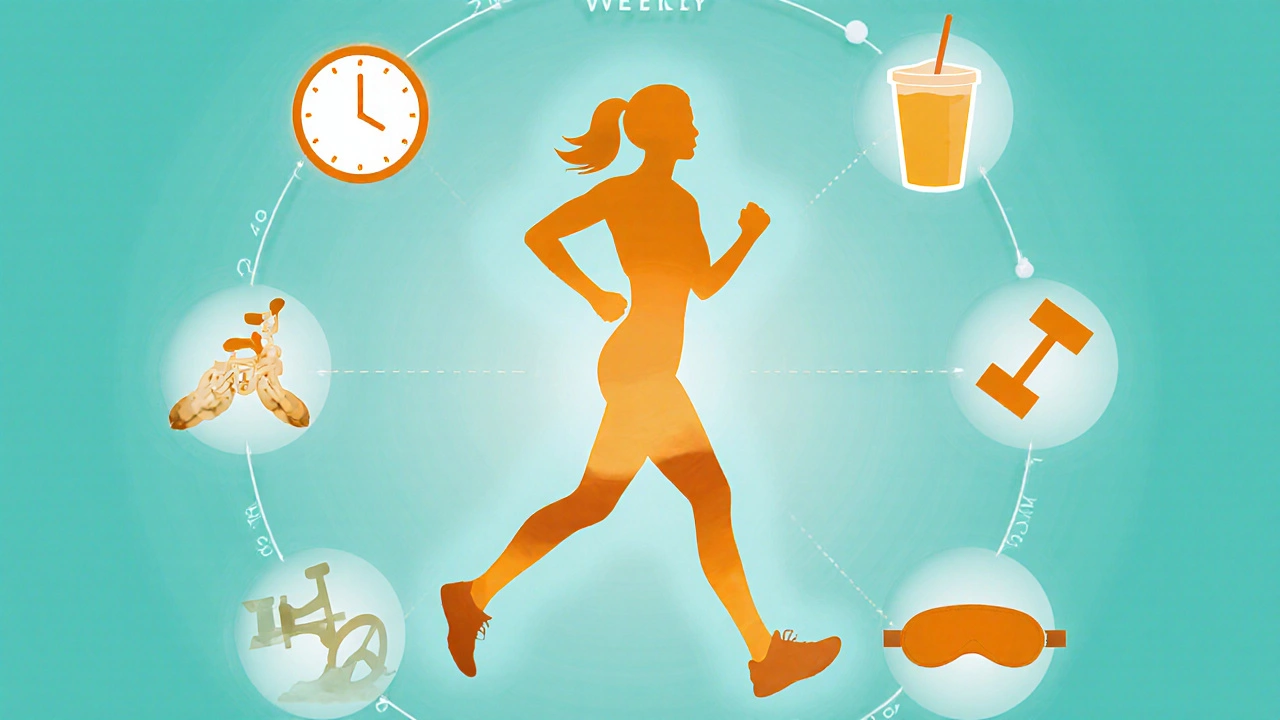Kelly Clarkson Weight Loss Plan Calculator
Personalize Your Plan
Enter your details below to get a customized weight loss plan inspired by Kelly Clarkson's approach.
Your Personalized Weight Loss Plan
Everyone’s been buzzing about how quickly Kelly Clarkson the Grammy‑winning singer and talk‑show host shed several pounds in a short span. The real question isn’t just the headline - it’s what concrete steps she took and whether those steps can fit into a regular person’s life.
Key Takeaways
- Clarkson combined intermittent fasting with a high‑protein, low‑carb diet.
- She added daily cardio and three short strength‑training sessions per week.
- Consistent sleep, stress management, and professional guidance kept her metabolism active.
- Her approach is adaptable - you can start with one component and build the rest.
Why the Spotlight on Kelly Clarkson weight loss?
Celebrity transformations often act as a quick‑fire case study. In Clarkson’s case, the speed of her results sparked curiosity because she didn’t resort to extreme crash diets or unsafe supplements. Instead, she leaned on evidence‑based tactics that nutritionists and trainers swear by.
Diet Blueprint: The Core Pillars
Three dietary strategies formed the backbone of her plan:
1. Intermittent Fasting (IF)
Intermittent Fasting an eating pattern that cycles between periods of eating and fasting helped her naturally cut calories without counting each bite. She followed a 16/8 schedule - 16 hours of fasting, an 8‑hour eating window.
2. Low‑Carb, High‑Protein Focus
Low‑Carb Diet a nutrition plan that reduces carbohydrate intake to promote fat burning kept insulin spikes low, while a High‑Protein Diet a regimen emphasizing lean proteins to preserve muscle mass ensured she felt full and maintained lean tissue during the calorie deficit.
Typical daily macros looked like 40% protein, 30% fat, 30% carbs, totaling around 1,600-1,800 kcal depending on workout intensity.
3. Mindful Nutrition Timing
She ate her largest meal after her post‑workout window (around 2pm) to maximize nutrient absorption and fuel recovery. Snacks were protein‑rich - Greek yogurt, cottage cheese, or a handful of nuts.

Exercise Regimen: Cardio Meets Strength
Movement was the second half of her formula.
Cardio Workouts
Cardio Exercise any activity that raises heart rate and improves aerobic capacity accounted for 30-45 minutes, five days a week. She alternated between HIIT (high‑intensity interval training) sessions and steady‑state sessions like brisk walking or cycling.
Strength Training
Strength Training resistance workouts that build muscle and boost resting metabolic rate was scheduled three times weekly, focusing on compound movements - squats, deadlifts, push‑ups, and rows.
Metabolism Boost
Combining muscle‑building with cardio elevated her basal metabolic rate. Metabolism the set of life‑sustaining chemical reactions in cells stayed active thanks to consistent protein intake and regular movement.
Professional Support: The Role of a Nutrition Expert
Clarkson worked with a Certified Nutritionist a health professional who designs personalized eating plans who helped fine‑tune her macro ratios and ensured micronutrient adequacy. Regular check‑ins prevented nutrient gaps and kept her energy stable.
Sample Weekly Blueprint
- Monday: 16/8 IF; 8am coffee (black); 12pm grilled chicken salad; 2pm HIIT (20min); post‑workout protein shake.
- Tuesday: Same fasting window; 12pm salmon with roasted veggies; 5pm 30‑min brisk walk; evening yoga for stress.
- Wednesday: 16/8 IF; 12pm turkey lettuce wraps; 2pm strength session (upper body); snack: cottage cheese.
- Thursday: 16/8 IF; 12pm beef stir‑fry (no rice); 5pm 45‑min steady‑state cardio (bike); herbal tea.
- Friday: 16/8 IF; 12pm shrimp avocado bowl; 2pm strength session (lower body); evening walk.
- Saturday: Flexible eating (no strict IF); focus on whole foods; 30‑min outdoor hike; light stretching.
- Sunday: Rest day; protein‑rich brunch; mindfulness meditation; prepare meals for the week.
Comparison of Core Diet Strategies
| Aspect | Intermittent Fasting | Low‑Carb Diet | High‑Protein Diet |
|---|---|---|---|
| Typical Calorie Range | 1,600-1,800 kcal (depends on window) | 1,500-1,700 kcal (carb < 50g) | 1,600-1,800 kcal (protein ≥30% kcal) |
| Meal Timing | 16‑hour fast, 8‑hour eating window | Regular meals, focus on protein/fat | Protein spread across 3‑4 meals |
| Pros | Simple, reduces overall intake, boosts insulin sensitivity | Promotes rapid fat oxidation, reduces hunger | Preserves lean mass, high satiety |
| Cons | May cause initial energy dip, not suitable for everyone | Can be restrictive, may cause keto flu | Requires careful planning to avoid excess calories |

Common Pitfalls & How to Avoid Them
- Skipping Protein: Without enough protein, muscle loss can offset fat loss. Aim for at least 0.8g per pound of body weight.
- Ignoring Sleep: Less than 7hours can sabotage hormones like ghrelin, leading to cravings.
- Over‑training: Too many high‑intensity sessions without recovery can raise cortisol and stall progress.
- Neglecting Micronutrients: A focused diet can miss vitamins; a multivitamin or nutrient‑dense veggies fill gaps.
Pro Tips for Replicating the Results
- Start with the 16/8 IF window; if it feels too restrictive, try a 14/10 schedule first.
- Batch‑cook protein sources (chicken breast, boiled eggs, tofu) to make meals quick.
- Use a heart‑rate monitor during cardio to stay in the 70‑85% max HR zone.
- Log your food and workouts in an app; visual feedback keeps you accountable.
- Schedule a monthly check‑in with a nutritionist or certified trainer to adjust macros.
Frequently Asked Questions
Did Kelly Clarkson use any diet pills or drastic supplements?
No credible reports show she relied on pills. Her team emphasized whole‑food nutrition and professional guidance.
How fast did she lose the weight?
Sources indicate roughly 10-12 pounds over a three‑month period, averaging about 1pound per week.
Can beginners try intermittent fasting safely?
Yes, but start with a shorter fasting window (12/12) and consult a healthcare provider if you have medical conditions.
What’s the role of cardio versus strength training in weight loss?
Cardio burns calories during the session; strength training builds muscle, which raises daily calorie expenditure even at rest.
Is this approach suitable for people with busy schedules?
Absolutely. The 16/8 window can align with typical workdays, and short HIIT or bodyweight circuits can fit into a lunch break.
Bottom Line
Kelly Clarkson’s rapid transformation wasn’t a magic trick; it was a blend of intermittent fasting, a protein‑rich low‑carb diet, consistent cardio, strength work, and professional support. By tweaking these pillars to match your lifestyle, you can aim for steady, sustainable weight loss without drastic crash methods.
